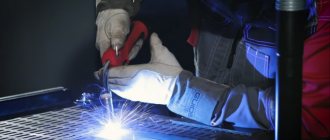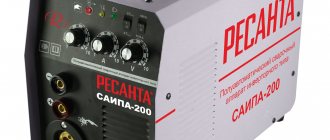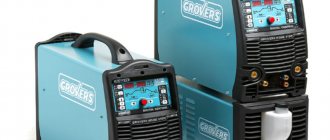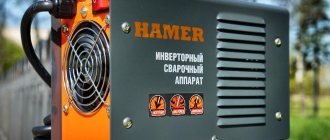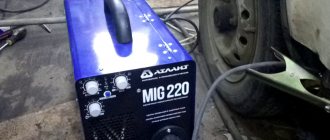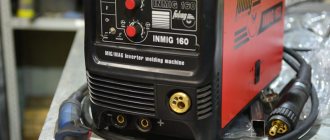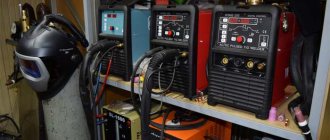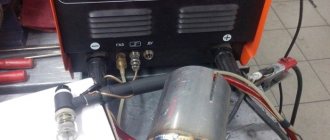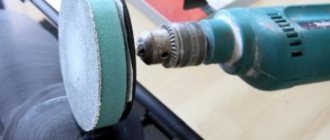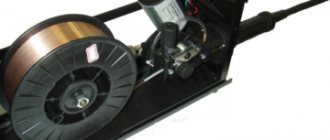A variety of welding machines are used for various types of work on creating metal structures. One of the most versatile and productive is the semi-automatic. It is distinguished by its high speed of welding, the ability to lay long continuous connections and minimal subsequent processing of the joint for painting. Semi-automatic machines can be large and small, expensive and cheap, but the key parameters regarding their suitability for specific types of work are hidden in their configuration and characteristics. We offer a number of tips from experts on choosing semi-automatic welding machines for various purposes.
Types of semi-automatic welding machines
Such equipment is not cheap, so you should correctly understand what types of semi-automatic machines there are and choose the appropriate device:
- According to the method of protection of welding seams that are created:
- submerged arc welding – rarely used;
- gas shielded welding is the most common type;
- welding using flux-cored wire – used together with shielding gases.
- By power source:
- transformer - have a large size and weight, used in stationary places of work;
- rectifier - quite large in size, consume a lot of energy, mainly used in stationary operating conditions;
- inverter - small in size and weight, require little power from the power source, used in everyday life, at home.
- By number of components:
- single-body - all the necessary parts are located in one block;
- double-body - two parts of the body that contain the necessary components. One part contains the wire feeder, welding torch and control panel, the other contains the welding power source, control monitor and ballasts.
- According to the method of movement in the workplace:
- stationary - mainly used in medium and large serial production for welding specialized posts;
- mobile – used at home, can be easily carried or moved on wheels.
- According to the method of connecting to the electrical network:
- single-phase - plug into the simplest household electrical outlet;
- three-phase - connected using special electrical connectors.
- According to the method of connecting the electrode wire:
- push type - the feed drive pushes the wire into the mouth of the welding torch;
- pulling type - the wire is pulled from the reel of the equipment surface using the feed drive, which is located in the burner handle;
- push-pull type - combines both types of wire feeding.
- According to the number of rollers that deliver the wire:
- a pair;
- two pairs.
- According to the form of welding current:
- constant;
- throbbing;
- impulsive.
- By connection polarity:
- straight polarity – minus on the electrode;
- reverse polarity – plus on the electrode.
The quality and speed of the required work will directly depend on the correctly selected semi-automatic welding machine.
Types of construction
The basis of the semi-automatic design is the welding current source or power supply. This node can be built according to one of two principles. The classic version is represented by devices based on a conventional step-down transformer.
But devices based on inverter converters predominate on the market. Welding equipment built on the basis of this innovative technology has been confidently pushing aside the classics for several years now, and there are good reasons for this.
The advantages of inverter semi-automatic machines are obvious and confirmed by repeated testing. Among the important advantages of inverters, the following should be highlighted:
- high stability of the electric arc, ensured even at low supply voltages;
- higher efficiency compared to transformer devices;
- relatively light weight and small dimensions of the devices.
The only positive features of transformer semi-automatic devices include the simplicity of the design, and the fact that in the event of a malfunction, an electrician who is not very highly qualified can repair it.
The designs of semi-automatic devices differ in the supply voltage used. Devices aimed at household consumers are powered by a single-phase 220 Volt network.
Devices intended for industrial use are often produced in a three-phase version. Such semi-automatic machines are capable of welding with higher currents, using thicker wire and in a more loaded mode.
Characteristics of semi-automatic welding machine
The semi-automatic welding machine is designed to perform arc welding using an electrode in a protective environment. With the help of such welding it is possible to make jewelry work on very thin metals. Rust protection and seam quality with such equipment increases several times, and work productivity increases.
One good welding machine should include:
- current source for welding - rectifier or inverter;
- mechanism feeding welding wire;
- welding torch;
- wires and cables that are needed to connect to the electrical network;
- package of welding cables – with holder and clamp;
- a sleeve for connecting protective gas to the source;
- a cylinder with gas for protection - carbon dioxide, argon or helium;
- terminal for controlling equipment with regulating and control equipment.
Set of semi-automatic welding machine
The most important characteristics of the semi-automatic welding machine are:
- Maximum current. This parameter affects the diameter of the wire used and the maximum thickness of the metal being welded. In the technical document, the manufacturer indicates the required current to work with any material.
- Network settings. Depending on the voltage, you can use more powerful devices with additional capabilities and functions. For normal use at home, a voltage of 220 V is sufficient.
- Duration of switching on. This characteristic shows how long the semi-automatic welding machine can work continuously. The higher this parameter, the longer the device can operate. For domestic conditions, 30% is enough, and for professional models – at least 60%.
Diagram of a semi-automatic welding machine
The performance of the equipment fully corresponds to the power consumption. The magnitude of the no-load voltage is different on the models of semi-automatic welding machine. The output current range for all modes is indicated separately. The weight of the device and its dimensions do not greatly affect the device.
Equipment selection
Before buying a semi-automatic device, first of all you should pay attention to its technical characteristics.
The main characteristic of a semi-automatic machine is the operating current at which welding can be carried out. This characteristic is directly related to the thickness of the metal that can be welded using this machine.
It’s good if the maximum current of the selected instance is 20 - 30% higher than the required one. This reserve will ensure more reliable and longer operation of the device.
Another important characteristic is the so-called on-time. This value is usually expressed as a percentage. It shows what part of a 10-minute period of time the semi-automatic machine is in operation.
For example, automatic welding machines operating on assembly lines of machine-building enterprises must provide an on-time of up to 100%.
To carry out repair work at the household level, a value of this indicator of 20% can be considered quite satisfactory. This parameter is the main one according to which semi-automatic welding machines are classified as professional or amateur. Also, its value largely determines the price of the device.
As for the supply voltage, of course, models with single-phase power supply are more practical in everyday life, which can be connected in almost any conditions - in an apartment, house, country house, garage.
Semi-automatic welding machine with gas
Welding various products made of copper, titanium or steel with a welding machine is the process of combining parts of metal by feeding wire to the joint. Along with this process, shielding gas is supplied. This gas ensures that the air does not negatively affect the heated and molten metal.
Welding using shielding gas does not require the additional purchase of expensive equipment. An even greater advantage is that work with carbon dioxide can be done anywhere without installing a special energy source.
When welding with gas, you can easily change the flame power to join different materials that have different melting points. Cast iron, copper, lead and brass weld much better, faster and stronger with this type of welding. If all rules and instructions are followed, the seams will be of the highest quality.
This type of welding can not only weld, but also cut and harden various metals. Welding can take place in an environment of argon, carbon dioxide or other inert gas. Special wire for welding with gas contains manganese and silicon, which protect against the negative effects of the external environment.
Saving time with this type of welding is easy because the electrodes do not need to be changed and the seams do not need to be cleaned after welding. When using pure carbon dioxide, the seam will have a scaly texture, and when adding argon, the seam will be smooth and even.
What types of equipment are there?
All models can be divided according to the use of filler material:
- units with flux;
- which operate in a gas environment (inert and active);
- welding with flux-cored wire.
When working with semi-automatic devices, a wire with a diameter of 0.5 mm to 3.0 mm or protective gases in pure or mixed form, located in cylinders, are used as a consumable electrode. Pure argon is in demand in industry.
Despite the availability of such equipment, it turns out to be expensive. But it is good to use in restricted areas where it is impossible to carry equipment.
Semi-automatic welding machine without gas
Welding in this way occurs using a flux wire containing a special welding powder. In appearance, welding with gas and without gas are similar due to the combustion of flux with the formation of a cloud of gas.
The main advantage of this type of welding is the absence of cylinders that are under gas pressure. The wire for work can be made of any material, it all depends on the metal being welded. After applying one seam, it is necessary to make another one on top, because due to the flux, slag can get onto the seam. After this, additional processing may be required.
Semi-automatic welding machine without gas
Working with such welding is a little more difficult: the wire must be fed into the welding area with force, and throughout the entire work you need to monitor the bends of the hoses, the polarity and the phase of the operation.
Design and purpose of a semi-automatic device
In semi-automatic welding, you do not need to supply the electrode yourself and replace it in the holder. A special wire is installed in the machine device instead of an electrode. It automatically enters the welding zone. The welder adjusts the required feed and, maintaining a certain distance to the metal, completes the work.
Various types of semi-automatic welding are easy to perform and do not require special knowledge. All equipment and parts are relatively inexpensive. It is the cost advantage that makes this type of welding popular both in large industries and in maintenance or repair companies.
Also, semi-automatic welding machines are widely used by private craftsmen, as well as non-professionals when working at home or in the country. Before purchasing equipment, you need to study the basics of this technology, determine the desired application, then select a specific device model.
The mechanism of semi-automatic equipment is universal for all types of welding. Main details of the device:
- power supply, control unit, display panel and manual adjustment elements;
- a hose cable for supplying wire, gas and current to the welding area (otherwise - a welding hose), a cable for connecting to ground;
- welding torch;
- mechanism for automatic wire exit;
- container with inert or active gas, special gas equipment.
In addition to the listed basic elements, some types of semi-automatic welding may require additional devices. For example: unwinders, pipe connection equipment, hose stands, restrictive screens, hoods, etc.
Semiautomatic welding machine for home
To select a semi-automatic welding machine, you need to decide how this device will be used. There is no point in purchasing expensive professional equipment for your home, so you should focus on household and semi-professional ones. Household devices are perfect for similar and simple work with the same metals. The second type of semi-automatic machine will fit well with people who carry out operations with materials of different structure and thickness.
Welding current is of great importance. You need to immediately decide what thickness of metal you will have to work with. Current to thickness ratio:
- up to 50 A – 1.5 mm;
- up to 80 A – 2 mm;
- up to 130 A – 3 mm;
- up to 160 A – 4 mm;
- up to 180 A – 5 mm.
These are average values; the exact value must be determined for a specific metal. It must be taken into account that the device should not operate at maximum power, because it can quickly fail. It is best to take a semi-automatic welding machine with a small reserve. If neat seams are required, then when choosing a device for your home you should pay attention to current regulation.
Supply voltage is one of the most important issues for welding work. For home operations, equipment with a single-phase connection is ideal. But very often there are power surges in the network, due to which electricity can be lost. Therefore, it is necessary to look at deviations at face value. If jumps are frequent, then the deviation should be as large as possible.
If finances allow you to take a more expensive model, then you should take an inverter semi-automatic machine. It has additional functions, current regulation and arc stability.
Manufacturer value
An important factor when deciding which semi-automatic welding machine to choose is the choice of manufacturer. It is difficult to give recommendations here, because there are situations when products from unknown manufacturers work flawlessly for years, and products from world brands do not fulfill their warranty period.
Despite this, it is still better to give preference to famous manufacturers. Mainly because, when selling a product, they usually create a network of service centers that provide maintenance and, if necessary, warranty repair of the device.
It is especially important to pay attention to this if you purchase an inverter semiautomatic welding machine, the repair of which requires specially trained, highly qualified personnel.
Semi-automatic welding machine for cars
A simple welding machine with a voltage of 220 V is suitable for car repairs. For more in-depth work with the machine, a powerful welding machine with 380 V is required. In this case, the welding seam will be much better and stronger.
A device with a mixture of argon and carbon dioxide in a ratio of 80 to 20 will help you get an even seam without splashes. You need to choose a manufacturer from leading European manufacturers; the investment will pay off for many years.
The switching duration must be selected at least 50%, and the power must be at least 150 A. Depending on the work, a choice must be made between mechanical and electrical wire feeding.
Transformer or inverter
- Transformers. Welding takes place using alternating current, which leads to the formation of scaly seams. There is also a high risk of metal spattering and sagging. The advantages of these models include their ease of operation and maintenance, and are easy to repair. In addition, transformers are resistant to voltage surges.
- Inverters. It features smooth seams, no splashes and compact dimensions. A wide range of metals are suitable for welding, such as cast iron, aluminum, stainless steels, carbon metals. Inverters are sensitive to voltage surges. In this case, simple adjustment to the necessary parameters is available.
Tips for choosing a semi-automatic welding machine
Before purchasing a device you need:
- Determine through which electrical network the work will be carried out.
- Find out what type of operations will be performed on this device.
- Learn how the welding process occurs using a semi-automatic machine.
- Pay attention to the manufacturer, reviews about working with him.
The quality of seams will be 1.5-2 times higher if you use foreign equipment. But their price exceeds the cost of domestic ones. It is important to determine what is most important to you personally.
Types of semi-automatic gas shielded welding
One of the most popular types of semi-automatic welding is gas shielded welding (MIG/MAG welding). This technology is suitable for joining parts made of any metal, while you can work freely both outdoors and indoors.
The device has a special device that feeds wire into the welding torch at a certain speed. The mechanism of the device consists of an electric motor, a gearbox, pressure and feed rollers and a cassette with the wire itself. The feed mechanism can be open or closed. There are also simple (contain one or two pairs of rollers) and complex systems (four or more roller units).
Wire feeding, controlled by a control panel of ten meters or more, is possible with intermediate mechanisms. Thanks to them, the welding area is increased. All additional mechanisms clearly interact with the main ones. This is how the semi-automatic device and gas device operate continuously.
Stages of this type of semi-automatic welding:
- preparation of welded edges;
- selection of welding materials;
- setting the operating mode of the device;
- the welding process itself, performed using special equipment;
- evaluation of work, checking the resulting seams.
The welding technology depends on the type of connection: butt, lap, corner “boat”, tee. In this case, the location of the seams is taken into account. So, horizontal seams should go at an angle back and from left to right without transverse vibrations. Vertical seams go from bottom to top for small metal thicknesses and from bottom to top for products with a thickness of 4 mm or more.
To fill the groove, transverse oscillatory movements are performed. When working, before a new welding approach, remove the directional ball at the end of the wire.
The described type of semi-automatic welding is simple and efficient. The only inconvenience is the constant use of a gas cylinder. If you need to constantly move from place to place, you can use a cart. The advantage of the technology is the low cost of gas (the cheapest option is argon gas). The method is also distinguished by high quality seams.
Cost of semi-automatic welding machine
The price of an automatic welding machine depends on many factors. The simplest option can be purchased for $200. For a home, the cost of the most expensive device will be $400. But professional equipment for welding will cost $1500-5000.
To use the semi-automatic welding machine correctly, you must study all the instructions and follow simple safety rules. To begin with, you should learn how to cook simple elements, and with experience move on to more complex designs.
4.2/5 — (5 votes)
Selection of models and brands
Our welding equipment store presents semi-automatic welding machines in several versions from different manufacturers:
- Aurora is one of the top companies in the welding equipment market. Since 2007, it has been supplying its equipment to the Russian market.
- Svarog is a popular Russian brand of welding equipment. As a distributor of Shenzhen Jasic Technology CO, it supplies the Russian market with inverter welding equipment. Svarog has 190 service centers throughout the country.
- Kedr is another Russian brand. Welding machines from this company are used in most enterprises.
- FoxWeld is one of the leaders in the rating of welding equipment manufacturers. The products of this company are distinguished by an increased service life.
Subtleties and types of semi-automatic submerged arc welding
According to GOST 8713 (1979), flux-cored wire must be used for permanent welding of materials made of steel and alloys based on iron-nickel compounds. The method is suitable for any welding work, including highly complex ones.
Mastering submerged arc welding skills will not require a lot of time and money. Flux is a granular powder; when burned, it forms a protective layer of gas and slag.
The electric arc type of semi-automatic welding using protective powder is a fairly simple, yet reliable method. It allows you to obtain high-quality and durable seams.
Submerged arc working involves joining molten metal of two different products in the presence of a protective powder. The metal and flux melt under the influence of the high temperatures of the electric arc.
When the granules melt, a special film is formed. It protects the weld pool from contact with oxygen and also prevents metal spattering.
The seam itself is covered with a thin layer of slag, and the joint cools evenly underneath it. The resulting crust can be easily removed mechanically. This is done without fail to visually assess the quality of the seam.
You can use a regular hammer to remove slag. When struck, the slag should crumble. Before this, you need to remove the remaining flux - they can be reused during the next welding.
Different types of semi-automatic submerged arc welding require the use of different types. Certain grades are selected to work with different types of steel (high-alloy or high-carbon), non-ferrous metals, alloys, etc.
Also, the fluxes themselves are divided into two types:
- Not fused (baked and ceramic). They are granules with alloying additives. They provide high quality welded joints.
- Fused. The compositions contain glass or pumice.
Non-fused types of flux are produced by grinding the base material and then combining it with liquid glass. Used to add alloying additives to the weld body. Fused fluxes are made by sintering materials.
For electric and gas welding, different types of protective flux are also used. They mainly differ in composition. Compositions for electric welding contain special salt granules based on fluorides and chlorides. This type of welding is performed by remelting slag with active metals.
The combination of salt and oxide solutions allows the use of mixed fluxes designed for welding alloy steel. Oxide fluxes are used for welding various types of steel with the presence of fluorine.
Types of semi-automatic welding are performed using flux-cored wire without gas. This gives better quality connections. The strength and other properties of the resulting compound are affected by the chemical compositions of the starting materials.
Steel welding wires are made in accordance with GOST 2246 (1970). The wire must be selected according to the material of the products being welded.
So, wire can be made based on three types of steel:
- alloyed;
- highly alloyed;
- structural, low carbon.
The cross-sectional size of the cores is up to 12 mm (this value depends on the thickness of the metal). The wire is supplied in coils up to 80 m long. If necessary, it is wound on cassettes or reels.
Steel wire used in various types of semi-automatic welding must be stored in a special way. It is necessary that the storage place is dry and does not allow moisture to pass through. If the metal is rusty, treat it with gasoline or kerosene.
To work with aluminum products, wires made in accordance with GOST 7871 and 16130 are used. Usually these are copper-plated wires, which do not need to be further processed during welding.
